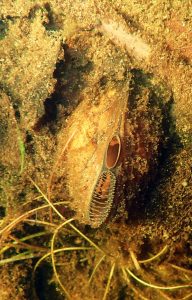
Empty mussels are common on shore and
in shallows amongst aquatic plants
Click on photo for larger version
The freshwater mussel Pyganodon cataracta occurs in abundance at Sandy Lake.
I have viewed many living specimens while snorkelling in the shallows (down to 2-3 m) and discarded shells are common amongst emergent wetland plants around the fringes of the lake. The latter could be the remains of river otter luncheons.
It was thus with some interest that I caught this title: A freshwater mussel apocalypse is underway—and no one knows why by Carrie Arnold on www.nationalgeographic.com, Dec 16, 2019. From that article:
Throughout the U.S. and Europe, staggering numbers of freshwater mussels are dying. To make the matter worse, no one knows why, prompting investigations into everything from infectious diseases to climate change to water pollution…
…mussels are crucial to their ecosystems, both by cleaning water of impurities and creating shelter for other species via their shells (after their decades-long lifespans are over)…Tony Goldberg, a wildlife disease expert at the University of Wisconsin-Madison, puts mussels’ importance more bluntly. Without them, he says, “the freshwater ecosystem will change forever.”
So together with the turtles and frogs and salmon and trout and other valued species we still find in Sandy Lake, the mussels are one to keep an eye on.

